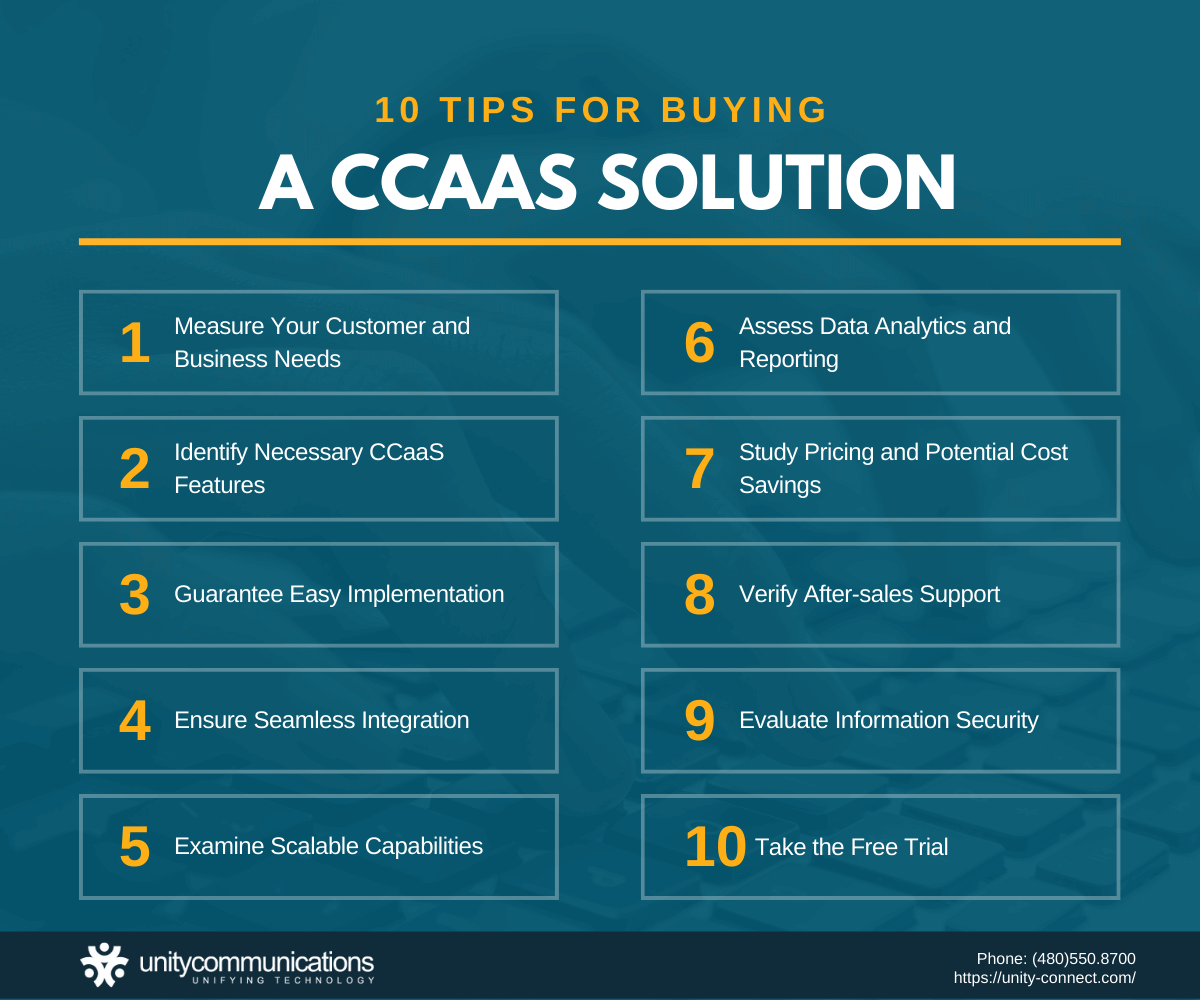Table of Contents
Does your customer service solution slow your team’s response to massive customer inquiries? Have you received overflowing negative consumer reviews because of it?
If so, you need a new, robust contact center as a service (CCaaS) platform to provide a superb customer experience. But before buying a CCaaS solution, you need to know what features and factors to consider.
You will find such critical insights by digging into this article.
Why Contact Centers Use CCaaS

Contact centers use CCaaS to help agents respond to customer requests, questions, and complaints. The cloud-based omnichannel infrastructure is more cost-efficient and scalable than a call center solution.
Although you can use and manage both platforms over a high-speed internet connection, CCaaS has better and more advanced features. The platform combines multiple communication channels, data management solutions, and automation tools. These features assist agents in delivering a personalized customer experience.
CCaaS Features You Should Know
When buying a CCaaS solution, you can choose from two accessible payment schemes. First, the pay-as-you-go setup lets you pay only for specific features you need. Second, you can sign up for a monthly or yearly subscription to access all the features listed below.
- An omnichannel dashboard provides a single view of integrated communication channels. So contact center agents can seamlessly and immediately address customer inquiries through calls, live chat, or email.
- Artificial intelligence (AI) simulates human intelligence to accomplish repetitive customer service tasks quickly and accurately. The technology includes machine learning (ML), natural language processing (NLP), speech recognition, and voice biometrics to ease large-scale processes.
- Robotic process automation (RPA) uses software bots to automate data collection, sharing, and analysis. Coupled with AI, RPA speeds responses to duplicate inquiries.
- A chatbot is an AI-powered self-service option that provides standard replies to simple customer inquiries via chat.
- Interactive voice response (IVR) automatically provides predefined responses to customer calls. IVR combines text-to-speech technology and a dual-tone multifrequency interface for smooth customer interaction.
- Automatic call distribution (ACD) is typically associated with IVR for automated incoming call routing. This feature helps customers find the best agents to solve complicated issues.
- Email response management (ERM) is similar to chatbots and IVR. ERM provides scripted replies to customer inquiries sent via email. It implements an automated ticketing system to expedite such responses.
- Customer relationship management (CRM) facilitates the rapid gathering, easy storing, and streamlined analysis of massive customer and business data.
- Cloud computing enables secure data storage, management, and processing using internet-hosted remote servers.
- Knowledge management serves as a digital content repository. This feature lets employees review workplace policies and procedures during their training and refreshers.
- Workforce management helps team leaders efficiently manage staff scheduling and distribute tasks. It simplifies agent performance monitoring and evaluation.
Due to convenience and cost efficiency, many businesses acquire CCaaS to boost customer service. Since the pandemic, the need for accelerated and personalized consumer support has increased. Hence, the demand for the platform has also grown.
In fact, Future Market Insights reveals that the global CCaaS market will reach $16 billion in 2032, registering a compound annual growth rate (CAGR) of 13.52% during the forecast period. The increasing adoption of advanced contact center technologies is helping to drive market expansion.
Tips for Buying a CCaaS Solution

After learning about CCaaS and its features, the next step is understanding how to purchase the platform. The insights below help you make a structured investment plan to ensure returns and avoid wasting funds.
With a CCaaS solution, you can improve your core capabilities while saving on customer service costs. Follow these ten tips before buying a CCaaS solution.
1. Measure Your Customer and Business Needs
Assessing your customer and business needs is the first and most important step in getting a cloud-based contact center solution. You must study changes in customer demands, preferences, and buying behavior. You must also learn about the challenges stopping you from providing unmatched consumer support.
Learning about such challenges lets you identify which CCaaS features you need to improve your customer service operations. It also helps you decide whether to sign up for a full subscription or stick to a retail-like setup for more cost savings.
2. Identify Necessary CCaaS Features
After clearly identifying your business needs, create a full list of the specific CCaaS features that meet your requirements. If you want to subscribe to all kinds of software, create a list of criteria to find the best CCaaS platform.
This method helps you decide whether the solution fits your customer service and budget plans. A cost-effective CCaaS platform must have the following:
- Advanced contact center features, tools, and capabilities
- Good market reputation, positive reviews, and numerous recommendations
- Easy-to-use, simplified user interface
- Application programming interface (API) for smooth integration with third-party apps
- Industry and government certifications
- Well-established security and data privacy policies
- Transparent payment terms
3. Guarantee Easy Implementation
When buying a CCaaS solution, ensure that you can implement it quickly. Consider software processing speed when choosing the best cloud contact center solution. Your team should not take too long to set up and boot the platform. Ensuring fast daily startups prevents delays in responding to customer inquiries.
4. Ensure Seamless Integration
When choosing your CCaaS (Contact Center as a Service) software, prioritize one that integrates flawlessly with your current systems like customer relationship management (CRM), ecommerce, marketing, finance, and data management platforms. This level of integration consolidates sensitive information, allowing agents to effortlessly transition between different solutions serving various functions.
These features not only quicken and tailor the customer service experience but also lighten the workload for your employees by streamlining collaboration and task allocation. Moreover, this approach can lead to cost savings, as it eliminates the need for comprehensive subscriptions.
5. Examine Scalable Capabilities
Look for a CCaaS solution that scales your customer service operations, especially during peak season. The platform should be easy to customize. Your agents should be able to immediately adapt to changes in customer demands and market trends.
Moreover, ensure the CCaaS software can accommodate multilingual and multicultural customer inquiries. This advantage lets you provide quick, personalized support to your global customer base.
6. Assess Data Analytics and Reporting
Choose a virtual contact center platform that lets you streamline data analysis and reporting while providing excellent customer service. The CCaaS solution should have AI and automation tools so your team can easily collect, manage, and make sense of massive data from daily transactions.
Such capabilities bring relevant insights you can use to enhance your core products and services. These results also inform and guide you in resolving problems in your customer service delivery.
7. Study Pricing and Potential Cost Savings
Buying a CCaaS solution requires a thorough budget plan to ensure investment returns and reduce operating costs. Otherwise, you will experience missed funds, delayed projects, and increased backlogs.
To avoid such inefficiencies, conduct a cost analysis to assess the value of purchasing cloud contact center software. The process helps you compare the pricing of various vendors’ services and identify which provider has the most potential to generate cost savings. It usually involves the following steps:
- Specify whether you want to purchase the full or partial CCaaS features.
- Sum up in-house expenses you can save by acquiring the contact center solution.
- Total your software acquisition costs.
- Deduct CCaaS procurement costs from in-house expenses.
- Get the platform after ensuring potential cost savings.
8. Verify After-sales Support
Do not forget to confirm whether a CCaaS provider offers after-sales support. This step is especially critical during the first few days, weeks, or months after buying the platform. Expect newly purchased software to have unexpected faults and glitches, even after a smooth installation process.
So make sure your chosen CCaaS provider is easy to contact in case of technical difficulties. Resolve any platform issue immediately to avoid mishaps in your daily customer service operations.
9. Evaluate Information Security
Assess the security and reliability of platforms when buying a CCaaS solution. According to IBM’s 2022 report, 45% of data breaches took place in the cloud. Cloud contact center software faces cybersecurity risks, threatening your sensitive customer and business data.
Choose a CCaaS platform with strong data security and privacy protections to avoid the high cost of threat mitigation. It must have the following features to strengthen cyber defense:
- Anti-virus scanning and mitigation
- Multifactor authentication
- Data encryption
- Biometrics identification
- Powerful network access control
10. Take the Free Trial
Grab the CCaaS vendor’s offer to test products at no cost. The free trial lets you try cloud contact center features and functionalities. The hands-on experience helps determine whether the software meets your customer service needs.
The initial testing also provides an overview of how to install, set up, and operate the CCaaS platform. It lets you assess whether the solution will streamline customer service tasks.
The Bottom Line

Your contact center is on the front lines, handling inquiries, issues, or complaints from countless customers daily. As technology advances and communication channels diversify, consumers increasingly expect swift and tailored customer service. Falling short of meeting these expectations can lead to dissatisfaction among your clientele.
This is where CCaaS (Contact Center as a Service) becomes invaluable. It enhances customer support capabilities with various features tailored to your business and customer needs. However, knowing the key considerations before investing in a CCaaS solution is important. With this knowledge, you can create a well-informed investment strategy aligned with your business objectives and financial constraints.
Should you be in the market for a comprehensive cloud-based contact center solution, consider contacting Unity Communications. They are an acclaimed service provider offering customizable, fully integrated CCaaS solutions, designed to elevate your customer experience and give you an edge in the dynamic omnichannel marketplace.




